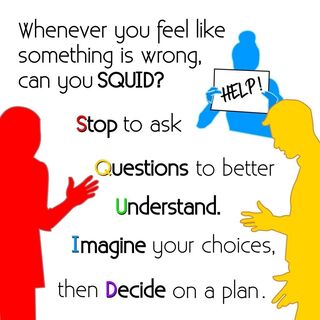Decision-Making
We Do Not Have to Be Passive Bystanders
Learn a 5-step intervention for making better choices when there is a conflict.
Posted July 28, 2022 Reviewed by Gary Drevitch
Key points
- We can follow 5 steps to mindful action, when we need it most: Stop, Question, Understand, Imagine, then Decide.
- The key to SQUID is noticing that something seems wrong, unlocking the door to conscious consideration.
- Interpersonal conflicts are common. Learning how to SQUID can help us make better choices, especially when emotions are running high.
- Whenever we see others in conflict, we choose what we do next, consciously or unconsciously. We don’t have to be bystanders.

by Dr. Philip Zimbardo with Dr. Mel Ganus
It’s summer 2022, a strange time to be alive, and an urgent time to learn how to SQUID.
Despite all the good humans can do, humanity is in trouble. Every time we look at the news, needless suffering seems unavoidable, from the pandemic to international violence, devastating climate effects, and much more, even in our own lives.
When we feel powerless, we are likely to become frustrated and confrontational. Conflicts among ourselves can easily escalate when we don’t know how to respond optimally.
Imagine you are witnessing a conflict between others at work or at home. What is your default response? Do you instinctively stay out of it? Or do you consider other options and determine ways you might be able to help?
Our autopilot passive response is never the best choice.
Often, we simply avoid trying to help. The bystander effect can be our default response. Instinctively we don’t want to risk getting involved in someone else’s problem. Reacting to situations without considering alternative choices can have problematic consequences. When we say something impulsively, we can unintentionally trigger someone else’s distress or anger, and can make things worse.
To help everyone make better and wiser choices in these situations, we have been teaching people how to SQUID.
SQUID is an intervention to trigger mindfulness when we need it most, especially when we feel like something is wrong. By being more mindful of the situations we are in, we can respond optimally when something doesn’t feel right. Awareness of our own instinctive reactions enables evaluation of our choices even before we make them. When someone else needs help, we can use SQUID to be an Everyday Hero, acting to make a positive difference in the lives of others.
How to use SQUID to improve our decisions
SQUID consists of five steps: Stop, Question, Understand, Imagine, and Decide. We already unconsciously use each of these steps in everyday decision-making.
- Stop when something feels wrong. The most important step is being able to interrupt our autopilot when we see a conflict. The faster we notice the signs of trouble, the faster we might be able to help. Somatic markers of distress such as a faster heartbeat or tightening throat can also clue us in that we should be more mindful. When we don't notice, our inaction might make things worse.
- Question. Starting with our internal dialogs, ask evaluative questions about what we specifically notice, and ask ourselves about the assumptions we are making. We can ask: "Why do I feel like something is wrong?" or “What’s really going on?” If we are trying to help others, we try to choose questions that can help us understand things from their point of view, such as, “What might be going through their minds right now?”
- Seek to better Understand the situation. By taking even a few moments to look beyond our initial impressions at the bigger picture, we can make wiser choices about what we do next. Try to look for more than one perspective about what is going on and why. Posing internal questions can help flesh out your understanding, such as, "What other factors should I consider?” or "What's triggering the reactions of other people involved?"
- Imagine your choices. As we try to improve on our understanding, we can start considering our options. One of the reasons we act without thinking is that we aren't imagining what could happen next. We use deductive approaches, anticipating how other people are likely to respond to different things we could say or do, or we think more inductively, starting with our goals for what we want to see happen and what we could try to do to achieve them.
- Decide what we want to do next. Even if we decide to follow our instinctive choice, and remain passive, at least we still practiced questioning ourselves wisely before that decision. Waiting for clarity or avoiding getting involved might be our best choice in the moment. We should not assume that all conflict situations require our personal intervention. But by having SQUID in the moment and considering our options, we can develop better decision making habits in all sorts of situations.
When and why we should SQUID
When we are in any situation that feels wrong, our emotional brain immediately starts reacting on autopilot. It takes a habit of conscious consideration to make wiser choices about what we do next. We can make better decisions when we routinely practice using SQUID.
SQUID can be very useful in many more situations beyond what we’ve described above. Whenever you notice a stressful situation, practicing the 5 steps of SQUID can help you feel less helpless by enabling you to make better decisions. Through triggering more mindful consideration, you can make better choices, have fewer regrets, and make a positive difference in the lives of others.
You can also teach others in your life how to SQUID, so that they have the tools to consider their options more carefully. Please consider sharing this post and connecting with us to learn more.
We thank our other contributors to this post: William de Melo, Stacey Quigley, Lukasz Garczewski, and Dr. Zanna Smith.


